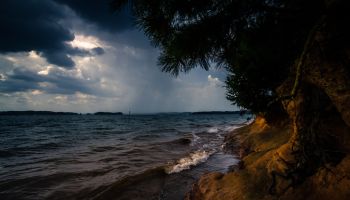NEW YORK – Tropical Storm Irene unleashed furious wind and rain on New York on Sunday and sent seawater surging into the Manhattan streets. But the city appeared to escape the worst fears of urban disaster – vast power outages, hurricane-shattered skyscraper windows and severe flooding.
A foot of water rushed over the wall of a marina in front of the New York Mercantile Exchange, where gold and oil are traded, and floodwater lapped at the wheel wells of yellow cabs.
But the city’s biggest power company, Consolidated Edison, said it was optimistic it would not have to cut electricity to save its equipment. The Sept. 11 museum, a centerpiece of the rebuilding of the World Trade Center site, said on Twitter that none of its memorial trees were lost.
And Irene made landfall as a tropical storm with 65 mph winds, not the 100-mph hurricane that had churned up the East Coast and dumped a foot of water or more on less populated areas in the South.
“Just another storm,” said Scott Beller, who was at a Lowe’s store in the Long Island hamlet of Centereach, looking for a generator because his power was out.
Irene weakened to winds of 60 mph, well below the 74 mph dividing line between a hurricane and tropical storm. The system was still massive and powerful, forming a figure six that covered the Northeast. It was moving twice as fast as the day before.
As a hurricane, Irene had already killed 14 people and left 4 million homes and businesses without power. It unloaded more than a foot of water on North Carolina and spun off tornadoes in Virginia, Maryland and Delaware.
And even after the storm passes in the Northeast, the danger will persist. Rivers could crest after the skies the clear, and the ground in most of the region is saturated from a summer of persistent rain.
But from North Carolina to New Jersey, the storm appeared to have fallen well short of the doomsday predictions.
“I think it’s a little strong to say we dodged a bullet. However, it certainly could have turned out worse for the Hampton Roads area,” said National Weather Service meteorologist Mike Montefusco.
In Virginia Beach, the city posted on Twitter late Saturday that initial reports were promising, with the resort area suffering minimal damage. Ocean City, Md., Mayor Rick Meehan posted wind readings and reported: “Scattered power outages. No reports of major damage!”
Charlie Koetzle was up at 4 a.m. on Ocean City’s boardwalk. Asked about damage, he mentioned a sign that blew down.
“The beach is still here, and there is lots of it,” he said. “I don’t think it was as bad as they said it was going to be.”
Under its first hurricane warning in a quarter-century, the nation’s largest city had taken extensive precautions. There were sandbags on Wall Street, tarps over subway grates and plywood on storefront windows. The subway stopped rolling. Broadway and baseball were canceled.
John F. Kennedy International Airport recorded a tropical storm-force wind gust of 58 mph. Kennedy, where on a normal day tens of thousands of passengers would be arriving from points around the world, was quiet. So were LaGuardia and Newark airports. So was Grand Central Terminal, where the great hall was cleared out entirely. Part of the Holland Tunnel was closed.
And 370,000 people in the city had been ordered to move to safer ground, although they appeared in great numbers to have stayed put. A storm surge of at least 3 1 / 2feet was recorded in New York Harbor, and water pressed into Manhattan from three sides – the harbor, the Hudson River and the East River.
















